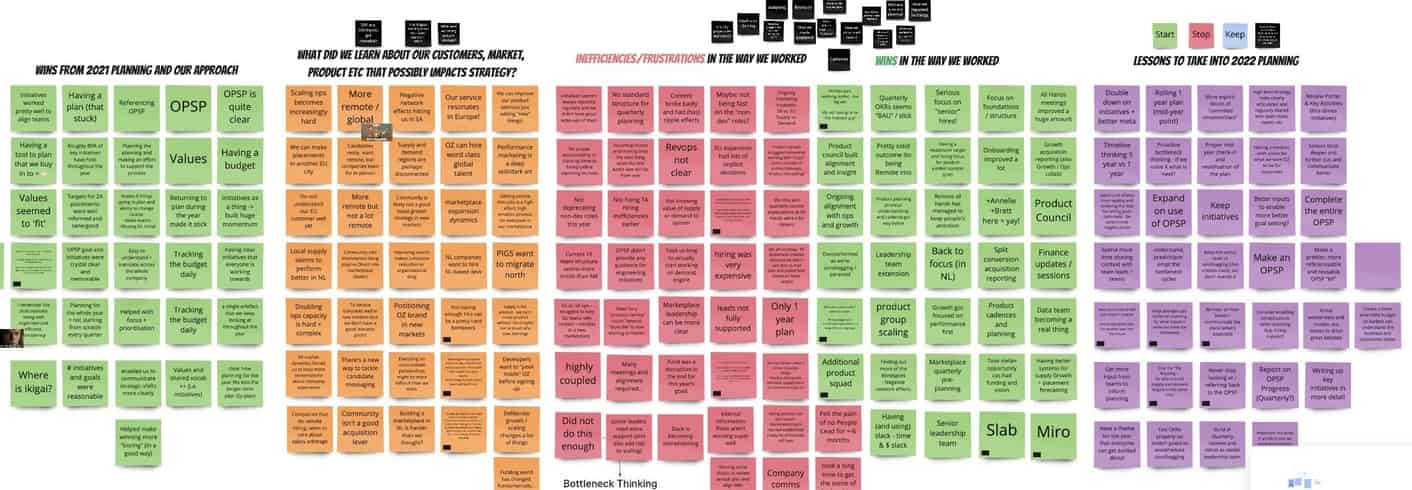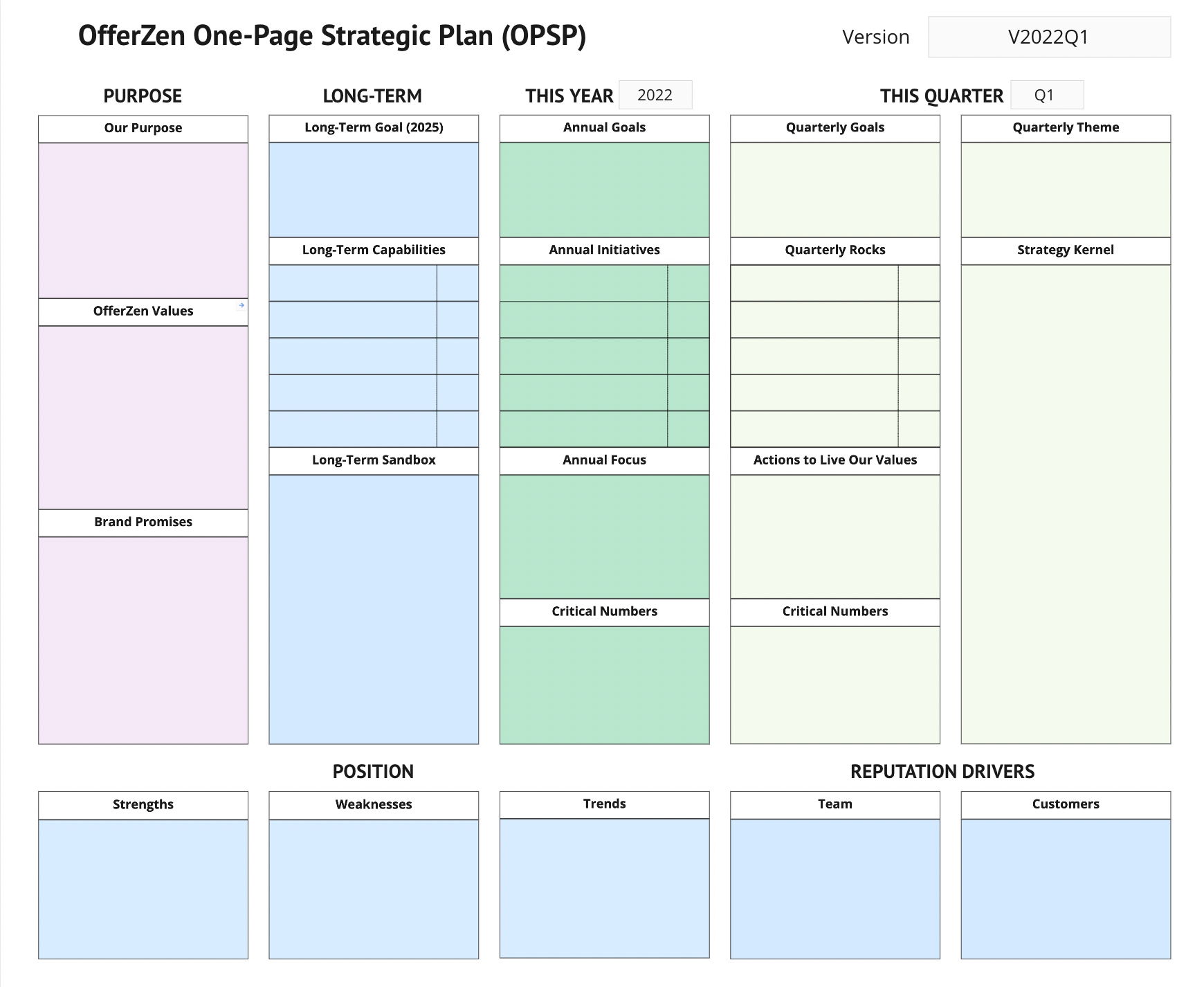How OfferZen does Annual Planning
Strategy and planning seems to be a bit of a black art for startups. I thought I'd share OfferZen's planning process in the hope that there are a few useful nuggets here. I don’t think we’re a bastion of good planning yet, but we have dramatically improved our process over the last few years and it works quite well for us.
First some context about OfferZen. We’re a talent marketplace for software engineers. My brother and I launched the company in South Africa and we bootstrapped for the first 5 years. We’ve recently expanded to Europe and raised our first funding. Our team is just over 120 and we’re remote.
Overview
At the end of each year we work on an annual plan for the next year and then each quarter we create a plan for that quarter.
The annual planning part consists of the following:
- Team survey
- Leadership retro
- Senior leadership offsite
- Communicating the plan
- Develop annual initiatives
- Budget & headcount
I'll explain what we do at each of these steps and drop some pro-tips along the way.
The outcome we're working towards
By the end of the planning process we want to end up with everyone in the company understanding:
- Our DNA: why we exist & the values with which we operate
- Core strategy: what our 3-5 year focus is and how we’re approaching it
- Annual plan: what the core things we want to accomplish in the next year
- Individual impact: What the plan means for them & how they will contribute
Our DNA or core strategy doesn’t change that much each year, but we still revise them during the annual planning process.
1. Team survey
Strategy is about making trade-offs, and good strategies usually make big tradeoffs. Large groups aren't known for making smart trade-offs and trying to build a good strategy with our entire company would be painful for everyone involved. Instead we have a smaller group (our senior leadership team) that ultimately decide on the strategy. However, it’s still incredibly useful to get input from everyone in the team because they often have completely new ideas and perspectives.
We’ve experimented with a few ways for the team to give input and the most successful has been to send out a simple Google Form.
Example team survey questions:
- What answers would the 2022 plan need to provide in order for you to add max value next year?
- What are the biggest opportunities for OfferZen that we should consider going after?
- What should we cut back on or stop doing?
- Anything else you think we should have on the agenda as we plan for next year?
These are hard questions to answer, so I give our team one week to complete them. Despite having very high expectations of our team, I’m always surprised at how thoughtful and valuable their responses are.
2. Leadership retro
In addition to the survey, we also get feedback in the form of a leadership retrospective of the past year. The focus is on how we planned and operated during the past 12 months.
We set aside 90-120 minutes and use a Miro board to run the session. After getting initial feedback we identify the key issues that came up and discuss those in detail.

For our 2021 leadership retro we used the following questions:
- Wins from this year’s planning and our approach
- What did we learn about our customers, market, product etc that possibly impacts strategy?
- Inefficiencies/frustrations in the way we worked
- Wins in the way we worked
- Lessons to take into next year’s planning
3. Senior leadership offsite
The offsite is attended by our senior leadership team (11 people in total) and the core strategic planning happens here. After three days we go home with a draft plan that is 80% of what the final plan will look like.
OfferZen is a remote company, but our senior leadership team still gets together in person twice a year for planning. Being together in person isn’t strictly necessary, but we’ve found that it’s a great opportunity to build stronger personal relationships.
One page strategic plan
We use the OPSP (one-page strategic plan) from Scaling Up as our primary strategic tool. The OPSP lives up to its name - it’s a simple, compact way to capture the core aspects of a company’s strategy. The goal of the offsite is to complete an updated version of OPSP.
We’ve tweaked the OPSP slightly to fit our needs better. You can check our template below:

Offsite Structure
We spend 3 days planning together:
- Day 1: Long-term plan
- Day 2: Annual plan
- Day 3: Initiatives & next steps
Our planning sessions used to involve a lot of whiteboarding, but the downsides (only one person can write on the board at a time) have caused us to stop using them. Instead, we use Miro on our laptops. My pre-pandemic self cringes at the idea of getting together in person only to use laptops, but it really does work better for us.
I usually facilitate our leadership offsites. It’s mostly fine but it does mean that it’s not always clear whether I am acting as facilitator or as participant.
My principles for running the offsite
- If you can’t join in person then you can’t join at all.
- Be firm on time, but don’t get too caught up with the agenda. Some rabbit holes are worth going down.
- Don’t assume consensus - some of the most valuable discussions will be about topics that you thought everyone agreed on.
- Surface disagreements and embrace conflict - a team that trusts one other will debate things.
- Keep the plan super simple - it’s easier to understand, remember and execute.
- Battle-test ideas - ask the hard questions now rather than encountering them for the first time during the year.
- Wordsmithing can happen asynchronously
Pro tip: As CEO you have the “loudest voice in the room”. Once people hear your perspective some portion of them will alter their view to match yours. Counter this by asking people to write down their thoughts prior to you sharing your perspective or waiting to share your opinion until last.
4. Develop annual initiatives
With the high-level plan in place the focus shifts to our annual initiatives. They are the big annual projects we undertake as a company that moves us closer to our long-term goals and capabilities.
Initiative write-up
Each initiative owner is responsible for making a detailed write-up of their initiative within two weeks of the offsite. Each initiative uses the same template and we stick to Amazon’s 6-page rule:
- What is the situation, problem, or opportunity? Include summary data as appropriate in this section and add the full data set in the Appendix.
- What is the ideal outcome and how would we measure success? Don’t describe the solution here. Describe the outcome or desired future state you want to achieve and how you would measure success.
- Are there any obstacles to achieving this ideal outcome? Consider both internal obstacles (e.g. resources, culture, staffing, conflicting priorities, etc.) and external obstacles (e.g. clients, competition, environment, etc.).
- What is your best proposed solution? Don’t give options here; give your best recommended solution. Include your expected short- and long-range results, as well as how you would test your solution early in the process and make adjustments as required. Be specific.
It may be tempting to have broad initiatives, but I’ve found that these tend to cause issues. The broader the initiative, the hard it is to hold someone accountable.
Initiative review session
After two weeks we then set aside a few hours to review the initiatives. The entire senior leadership team attends this session.
For each initiative we follow a structured process:
| Step | Duration | Notes |
|---|---|---|
| Read initiative | 12min | Nobody speaks |
| Clarifying questions | 5min | Anyone asks, Initiative Owner answers; repeat |
| Reaction & suggestions | 5min | Everyone except Initiative Owner speaks, one at a time |
| Summarise takeaways | 5min | Only Initiative Owner speaks |
| Safety-Check | 1min | Anyone speaks; Silence means consent |
This process may seem a little formal but we’ve found that it generates much more specific and actionable feedback. This process will likely result in a few of the initiatives needing rework.
Once we’re happy with the initiatives we add them to Slab, our company wiki.
5. Communicating the plan
Long-form plan
After an offsite, the senior leadership team usually has a huge amount of shared context, but the rest of the team does not. So we write up clear reasoning for each of the elements of our OPSP and add that in Slab alongside the initiatives.
All Hands
Once we’ve written up a long-form version of the strategy I take the team through it during our weekly All Hands meeting. I’ve found that we can’t cover everything in a single all-hands, so we break it up into 2 parts.
In the first All Hands of each month, we review our progress towards the quarterly plan, so the whole team is kept up to date.
Budget & headcount
A lot of companies follow a very strict (and long) budgeting process. I don’t believe that sticking to a budget at all costs makes sense for startups so we aren't budget Nazis. That said, we do want to get a reasonable sense of the financial implications of our plan.
We start off the budgeting process by establishing two hard constraints
- Maximum burn: How much of our funding are we willing to burn over the next year? We bootstrapped for 5 years before raising our first funding recently so being frugal is in our DNA.
- Maximum headcount: How much are we willing to grow the team over the next year? If we grow our team too fast we not only ramp up our burn but also add cultural risk.
We have fairly detailed model of our marketplace that links output metrics (e.g. Revenue) to input metrics (e.g. leads). From there we can get a good idea of how many leads we need, what marketing spend we should expect etc.
Next we dive into Google Sheets and project our monthly revenue and costs for the year. We also ask senior leaders to provide their hiring plans so that we can calculate headcount and staff costs. The result of this is a kind of Oprah budget where everyone gets what they want. Based on the constraints we debate, negotiate and tweak the costs until the plan looks reasonable.
With the budget done we’re ready to crush the year! 🚀